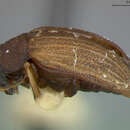Comprehensive Description
(
Anglèis
)
fornì da Smithsonian Contributions to Zoology
Colaspis suilla (Fabricius)
Galleruca suilla Fabricius, 1801:417.
Colaspis suilla.—Olivier, 1808:492.—Horn, 1892:223.
Fabricus’ description of Galleruca suilla is as follows: “... nigro-aenea, obscura, elytris pedibusque cinereis. Habitat in Carolina, M. D. Bosc. Statura omnino C. brunnea at caput, thorax, et corpus nigra, aeneo obscure nitida.” In Horn’s revision of the boreal North American species of Colaspis, he has listed suilla as “variety” of brunnea along with C. flavida Say, flavicans Lefèvre and costipennis Crotch. Horn described suilla briefly as having a brown thorax with some metallic coloration. And there the matter has stood for the past 80 years.
In 1950, I examined the Bosc collection in Paris and found two specimens labeled “G. suilla Bosc.h. in Caroline.” At that time I wrote in my notes, “This is not Colaspis but may be a species of Metachroma,” of which then I did not have the intimate knowledge to name as to species. Later, when I came to work on the genus Colaspis, I noted that Olivier in describing suilla wrote that the elytra were with “elevated lines” (costae) and with rows of punctures between, which description did not apply to the two specimens labeled “suilla” in the Bosc collection. Following this description Olivier described as Colaspis lurida the species I had seen labeled “suilla” in the Bosc collection. Olivier’s illustration of lurida clearly shows the single striate punctate elytra of a species of Metachroma. Unfortunately, however, Olivier’s illustration of suilla, next to that of lurida, does not show clearly either the elevated lines or the two rows of punctures that Olivier described, and even the coloration is not like that of any species of Colaspis that I know. This illustration has undoubtedly been a deterrent to entomologists in recognizing suilla.
Mrs. Zimsen in her book on the Fabrician types lists one specimen of suilla in the Fabricius collection, and on my writing to Copenhagen about the specimen, it was sent to me for study. It is not the same as the specimens in the Bosc collection labeled “suilla,” but a species of Colaspis that corresponds with the brief Fabrician description. The existence of this specimen in the Fabrician collection coupled with Olivier’s clear description of it are sufficient for me to decide that this one and not the two in the Bosc collection should be regarded as the type of suilla. Possibly the two labeled so in the Bosc collection are the result of some later transference of the label from a lost or disintegrating specimen of Colaspis.
This specimen from Denmark represents a species with dark brown, sometimes piceous, head and prothorax and somewhat paler reddish brown elytra, the elytra having dense punctation with four narrow paler reddish brown costae on each elytron. Probably this is the one that Say described as a variety of Eumopus flavidus having “interstitial spaces of the elytra black, beneath except feet black.” The beetles are considerably smaller, more rotund and less elongate than in the group comprising C. flavocostata Schaeffer, C. pini and C. pini schotti Barber, although in coloring they are similar. Colaspis costipennis Crotch differs from all of them by having usually a distinctly green prothorax and head also with greenish luster and frequently the elytral punctures have an aeneous luster. The wide, pale, polished, pale yellow costae of costipennis are nearly as wide as the punctate intervals and wider than in any other species from the United States. Sometimes costipennis specimens lack the aeneous coloring, being deep reddish brown instead, but the wide elytral costae are always there to distinguish this species. This specimen from Denmark that I have chosen as lectotype of suilla is the smallest specimen of the species that I have seen. It is a male measuring approximately 3.5 mm in length. I have seen only two other specimens that correspond very closely with the type, one from Southern Pines, North Carolina, and the other from Mt. Vernon, Alabama, both also males, but somewhat larger. I have dissected both of these and their aedeagi are not at all like that of C. brunnea, being narrower and not bent before the apex, and the apex is much narrower. Following is my detailed description of the type specimen.
DESCRIPTION:—Approximately 3.5 mm in length, oblong oval, moderately shiny, densely punctate, with dark brown head and prothorax, beneath dark brown, prosternum with very faint metallic blue luster, abdomen reddish brown with tip paler, elytra deep yellow brown, legs yellow brown, antennae on type specimen broken with only eight joints of one antenna left, which is pale yellow brown with 7th and 8th joints dark.
Head with interocular space more than half width of head, finely punctate above, clypeus also finely punctate and not very distinctly outlined, labrum yellow brown, faintly emarginate anteriorly. Prothorax with sinuous or slightly angulate sides, widest below middle, a tooth at each corner, moderately convex, shining dark brown, very densely and rather finely punctate. Scutellum brown. Elytra three times as long as prothorax and a little wider, yellow brown, very densely punctate between the four very narrow elevated lines on each elytron that are scarcely costate and without median lines between the double rows of punctures in the intervals. In interval near suture punctures becoming single in apical part, in second interval single only near apex, in third interval double almost to apex, and in 4th interval mostly a single row next to margin. Length 3.5–1.8 mm.
LECTOTYPE.—Male, in Fabricius’ collection at Copenhagen, Denmark.
- sitassion bibliogràfica
- Blake, Doris Holmes. 1975. "The costate species of Colaspis in the United States (Coleoptera: Chrysomelidae)." Smithsonian Contributions to Zoology. 1-24. https://doi.org/10.5479/si.00810282.181
Colaspis suilla: Brief Summary
(
Anglèis
)
fornì da wikipedia EN
Colaspis suilla is a species of leaf beetle. It is found in North America.
- licensa
- cc-by-sa-3.0
- drit d'autor
- Wikipedia authors and editors

